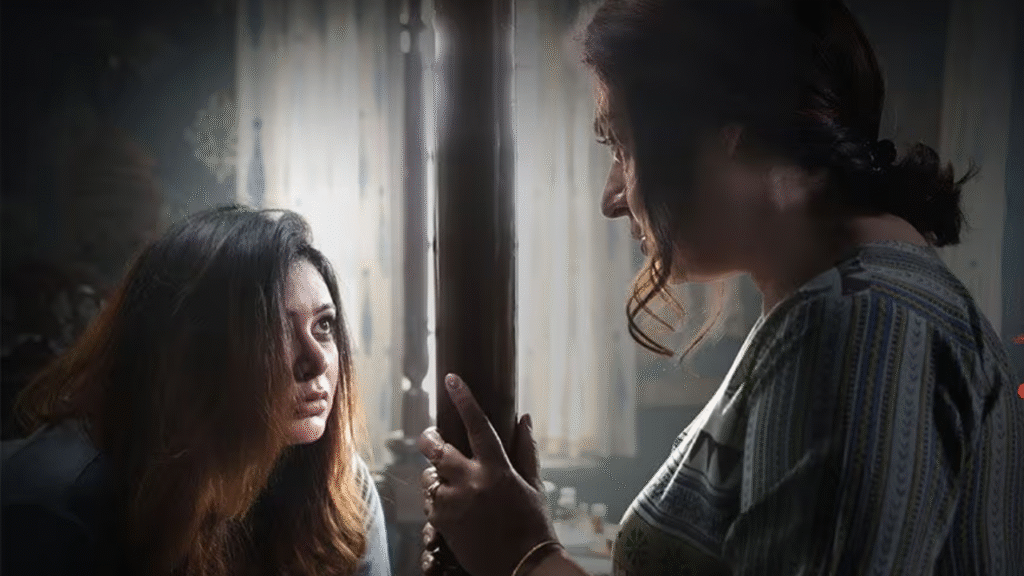Language: Bengali
Age Rating: U/A
Genre: Drama, Horror, Thriller
Released in Theatres: June 6, 2025
In this Batshorik Movie Review, we delve into Mainak Bhaumik’s latest cinematic offering—a Bengali horror-drama that weaves supernatural chills with deep emotional undercurrents. With an intimate story set in an old Calcutta house, the film unpacks themes of grief, guilt, and the unspoken strain between two women bound by loss. As the ghost of a dead husband lingers—real or imagined—Batshorik thrives in silence, tension, and atmospheric storytelling.
Plot: Haunted by Loss, Bound by Memory
Almost a year after the death of her husband Neel, Brishti (played by Ritabhari Chakraborty) struggles to adjust to a life that still echoes his presence. Into this space walks Swapna (Satabdi Roy), Neel’s older sister, who moves in to support Brishti—or perhaps, to supervise her. What begins as a fragile domestic arrangement slowly warps into something more unnerving.
Check Out: Sonar Kellay Jawker Dhan Movie Review – A Gripping Bengali Treasure Mystery
The house, quiet yet charged with emotion, becomes a container for past trauma. Strange occurrences—flickering lights, sudden sounds, shifting shadows—begin to unsettle Brishti. But is the house haunted by Neel, or are these manifestations of guilt and unresolved tension between the two women?
Rather than rely on conventional horror tropes, Batshorik crafts a slow-burning mystery that unfolds in layers, mirroring the complexity of grief itself.
Performances: Subtle Power from a Stellar Duo
Ritabhari Chakraborty delivers one of her most nuanced performances as Brishti. She captures the numbness of loss with remarkable restraint, letting silence and stillness speak louder than words. Her gaze—haunted and searching—anchors the emotional core of the film.
Satabdi Roy, returning to the screen with understated gravitas, portrays Swapna with remarkable control. Her performance avoids the clichés of the domineering in-law and instead gives us a woman struggling with her own grief, her presence both grounding and intrusive.
Together, Ritabhari and Satabdi create a tension-filled dynamic that holds the viewer’s attention throughout. Their unspoken conversations—glances, pauses, half-finished sentences—carry the weight of unresolved grief and suspicion.
Direction and Tone: Slow-Burning Horror with Emotional Depth
Mainak Bhaumik takes a bold step away from jump-scare-heavy horror, opting instead for atmospheric dread. The pacing is deliberate, allowing space for the viewer to observe the growing discomfort between Brishti and Swapna. The director invites the audience to sit in the silences, to absorb the discomfort, and to question what’s real and what’s not.
The tone is quiet but emotionally potent. This isn’t horror for the faint of heart—it’s horror for those who understand that sometimes, the scariest things are the emotions we bury and the people we cannot fully understand.
Cinematography and Sound Design: A Character Called Home
The house in Batshorik is not just a setting—it’s a character in its own right. With its antique furniture, dim hallways, and forgotten corners, it breathes history and sorrow. The cinematography captures its decaying beauty with reverence, using shadows and framing to create an ever-present sense of being watched.
The sound design avoids dramatic crescendos and instead embraces whispers, creaks, and silence. When music does enter, it blends seamlessly into the narrative—heightening emotion without overwhelming it.
Check Out: Aamar Boss Movie Review – Rakhee Gulzar’s Comeback is a Heartwarming Win for Bengali Cinema
Strengths and Weaknesses
What Works:
- Riveting performances by Ritabhari Chakraborty and Satabdi Roy
- Emotionally resonant and richly layered narrative
- Atmospheric visuals that heighten psychological tension
- A fresh take on horror that prioritizes emotional truth
What Falters:
- Some scenes linger a bit too long, testing the audience’s patience
- A few dialogues feel undercooked compared to the film’s visual storytelling
Cultural and Emotional Relevance
Batshorik adds a meaningful entry to the growing genre of Indian horror rooted in domestic spaces. More than just a ghost story, it’s an exploration of how families process grief differently, how silence can be a scream, and how homes—especially ancestral ones—carry the weight of memory.
The film’s commitment to portraying female grief, in particular, is both poignant and rare in mainstream cinema.
Final Verdict: ⭐️⭐️⭐️⭐️½ (4.5/5 Stars)
Batshorik may move slowly, but it moves with purpose. Through powerful performances, visual poetry, and an emotionally intelligent script, it stands out as a horror film that dares to be quiet—and in doing so, speaks volumes. It’s a story of two women, a house full of memories, and the ghosts we carry inside.
Should You Watch It?
Absolutely. If you’re a fan of horror that goes beyond the surface—where the scares come wrapped in emotional complexity—then Batshorik is well worth your time. It’s not just a movie about things that go bump in the night; it’s about the things that linger long after the crying has stopped.


